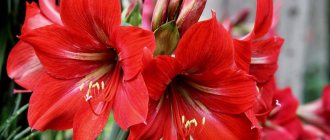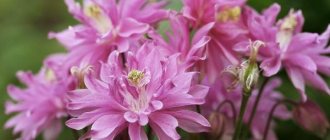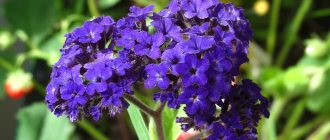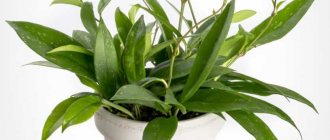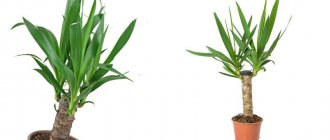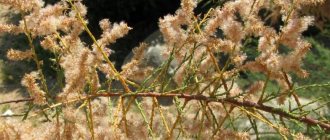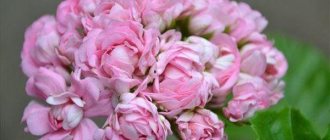Brief description and characteristics
The culture was bred by Japanese breeders more than half a century ago from a combination of tree and herbaceous species. Being a hybrid, it differs somewhat from the popular red, white and pink varieties both in planting characteristics and in the duration of flowering.
Peony yellow
On average, yellow peonies delight gardeners for 3-4 years. The shrub reaches a height of 90 cm–1 m, flowers can grow up to 20 cm in diameter. Flowering period: late May - early July, depending on the variety.
Application in landscape design
Peonies have always been popular in landscape design. Yellow shades look especially advantageous on the site. This is one of the few plants that can be planted in a separate flower bed on a hill or green lawn.
Yellow peonies can become the centerpiece of the garden if you place them at the front entrance of your home. Designers advise planting them in relaxation areas near your favorite rocking chair or near an open kitchen. Flowers can exist next to garden scented geranium or white tansy. Such a neighborhood will favorably emphasize the yellow color, but will not hide the advantages of other plants.
Note! It is not necessary to combine peonies with other flowers, since they have an incomparable advantage over them in shape and height.
Yaos Yellow, or Yao's Yellow
The most famous variety of Chinese tree peony. Huge, up to 2 m tall, bush. It begins to bloom early and abundantly. The flowers are gigantic, 20-23 cm in diameter, consisting of densely growing soft cream-colored petals. Golden stamens give the flowers a yellowish tint. The aroma is rich.
The variety is frost-resistant, can withstand temperatures below -30 C, and does not require covering. Hardy and disease resistant.
“Yellow Yaos” is planted on the sunny side of the site in a place protected from the wind. Since the plant grows well, it requires sufficient space.
Popular varieties
Apple varieties: the best red, yellow and green varieties
The world's first yellow peonies were very dull and lost their color in the sun, turning into a semblance of their white relatives. Thanks to modern breeding, all three types - herbaceous, tree-like and hybrid - can have any shade: from soft yellow to honey.
Herbaceous
Herbaceous yellow peony is one of the most common varieties in Russia. It includes 7 representatives and is distinguished by a delicate aroma and natural creamy yellow color.
Herbaceous yellow peonies
Varieties:
- Yellow peony variety Lemon-chiffon. It was developed in the Netherlands and quickly became popular throughout the world. With its rich, lemony tone and incredible height, it regularly ranks at the top of color charts. The diameter of the flower reaches 22 cm.
- Golden chariot. Considered one of the favorite flowers in China. The bud is double, has a natural yellow color, reaches 15 cm in diameter, resembling a crown in shape. Blooms mid-season and is ideal for cutting.
- Variety Golden Halo. Pale yellow in color. It grows no more than 70 cm, the diameter of the flower is up to 13 cm. It is unpretentious when combined with other flowers.
- Sunny fight. Terry, distinguished by a delicate creamy color. Plant height – up to 75 cm, flower diameter – up to 16 cm.
- Golden Wheel. It is distinguished by a yellow-green hue, spreading shape of the bushes and a height of up to 90 cm. The diameter of the flower is up to 15 cm. It begins to bloom in May. It is unpretentious in terms of soil composition even in coniferous areas.
- Gold Mine. Leads at the beginning of flowering. This double flower has a light yellow color and a diameter of up to 16 cm. It reaches a height of 80-90 cm. It is frost-resistant.
This is interesting! The variety Sunny Boy or Sunny Boy is a popular exhibition plant, but is quite rare in private gardens and summer cottages.
Tree-like
Tree peonies got their name because of their similarity in shape to small trees. They are sometimes called deciduous shrubs. They can grow up to 2 m. The stems grow with renewed vigor every season and do not wither in the winter.
Tree-like yellow peonies
Popular varieties:
- Variety Midday Heat. It has a pronounced lemon color, rich aroma and a height of up to 120 cm. It blooms from late June to mid-July. In hot summers you can expect to bloom twice.
- Yellow Yao. One of the most frost-resistant species. He is less susceptible to diseases than others. It can begin flowering in mid-April. Typically one plant has about 50 flowers per season.
- Gold Placer. One of the brightest yellow peonies. It has an orange-honey color with pink splashes. It begins to bloom in early June.
- Variety Academician Sadovnichy. The lowest of the trees. Its stems reach a height of 1 m. The flowers are pale yellow with a pink tint.
- Flowers Souvenir de Maxime Cornu. They have a rich creamy yellow color with a pink border around the edges. Flowering begins no earlier than mid-July. When cut, it is most resistant to wilting.
- Peony Kuindzhi. It has a calm yellow color with a red tint closer to the middle. It is the tallest of the tree-like ones - up to one and a half meters. There are a lot of flowers on the bush, they quickly replace each other and fall off.
This is interesting! The aroma of many tree peonies is reminiscent of citrus fruits.
Hybrid
These yellow peonies are a unique combination of the best qualities of their herbaceous and hybrid peonies. They are easy to plant and care for, but have lush, long-lasting blooms and rich colors.
Hybrid yellow peonies
Popular varieties:
- Variety Viking Full Moon. One of the most unpretentious. It has the shape of a herbaceous bush. The flowers are small, yellow-green with a bright burgundy disc in the center.
- Bartzella. One of the most popular varieties. It is distinguished by a tea shade with red splashes and huge double flowers. The herbaceous bush reaches a height of 100 cm. It usually blooms in early July.
- Going Bananas. The color resembles a banana and is distinguished by simple flowers no more than 20 cm in diameter. The height of the bush is about 65-70 cm. Flowering begins closer to mid-July.
- Variety Singing in the Rain. One of the most expensive and luxurious. The shade is reminiscent of grapefruit pulp, the aroma is light and unobtrusive. The height of the stems is up to 80 cm, the diameter of a semi-double flower is up to 20 cm.
- Canary Diamonds. It is distinguished by lush flowering and a bush height of up to 1 m. The color is rich, yellow with a creamy tint. It is universal in planting, can grow in almost any soil, and is frost-resistant.
- Border Charm. It is distinguished by a creamy shade of lush double flowers with a diameter of 20 cm. The height of the bush is 50-70 cm. The pronounced aroma is reminiscent of the smell of citrus fruits. Blooms profusely and is frost-resistant.
- Variety Yellow Crown. It is the yellowest of all the varieties described above, the flowers reach 15-17 cm in diameter. Yellow Peony begins flowering in mid-May and is characterized by long flowering. When cut, it decorates bouquets for an average of 7-10 days.
Note! The Singing in the Rain variety got its name due to its high resistance to heavy rain and cold.
High Noon, High Noon
Tree peony High Noon (Hai Nun) – tall, 1.5-2 meters. It blooms with bright, large (up to 17 cm in diameter) yellow flowers of a rare pink shape. The petals are bright yellow, lemon, reddish at the base. Flowering is abundant, begins in May-June and lasts 2-3 weeks. The American Peony Society awarded this variety a gold medal in 1989.
The stems of the plant are straight, thick, and do not die off in winter. Every year new stems grow. Despite the fact that the plant is cold-resistant and winters without shelter in the European part of Russia, it is necessary to cover it for the winter in those areas where the climate is quite harsh. To do this, use spruce branches, dry leaves or burlap.
Peonies are planted from mid-August to the end of September. They require systematic watering, constant weeding and loosening of the soil.
Basic rules for planting and growing
Ito-peonies - what kind of hybrid species is this, planting, propagation and care of hybrids
These yellow flowers are planted in open ground using root cuttings branched from the bush. The division operation is carried out independently or a ready-made cutting is purchased. When purchasing, they are guided by a 3-4-year-old peony division with 2-5 growth points (or buds). The seedling should not have suspicious growths, be too dry or wet. It is better if the root system is about 20 cm long.
Planting a yellow peony in open ground
Timing and features of planting
Planting usually occurs in the fall, around mid-September - a month before the onset of frost. The root system should send out shoots before the onset of cold weather.
Peonies planted in spring have a weak, undeveloped root system that is prone to disease. This is explained by the fact that in the spring the peony’s task is to bloom, so all its strength goes to the formation of buds and leaves. Planting in spring is possible from mid-April to early May. It depends on the timing of flowering. For example, the Yellow variety peony begins to form buds already in early May, so it is planted no later than the beginning of April.
Important! After planting in open ground, yellow peonies bloom for 3-4 years.
For successful growth and flowering, you need to choose the right location. Places rich in sunny color throughout the day are suitable. The flowerbed should not be placed closer than 1 m to the walls of buildings and structures on the site. The shade is detrimental because it slows down flowering.
The recommended distance between bushes is from 1 to 1.5 m. The landing site should not be subject to flooding during rains or melting snow.
The place for the peony should be sunny
Particular attention is paid to the choice of soil. Cultivated loamy soil is best suited. The key recommendation will be good moisture holding capacity and drainage of the soil for planting. The soil should not be excessively wet.
Helpful advice! To make the soil neutral or moderately acidic, add a bucket of sand to the hole when planting - if the soil is clay, or a bucket of clay - if it is sandy.
The seedling should be carefully inspected before planting. Damage or signs of rot are trimmed with a sharp knife and then treated with wood ash. If the seedling is dry, there is no point in planting it.
Step-by-step instructions for planting yellow peonies
- Dig a hole up to 1 m deep, the bottom of which is lined with a drainage layer (gravel or garden brick).
- Fertilizer is prepared right in the pit. It can be specialized for perennial plants or a mixture of humus, ash and Superphosphate with soil.
- Soil is applied to the fertilizer around the edges.
- A seedling is placed in the hole, straightening its roots to the sides and down. The buds on the seedling should be 3-5 cm underground.
- A little river sand is poured around the seedling and carefully covered with soil.
- Form a watering circle and water carefully.
After planting, use at least 10 liters of water for each peony bush
Planting peonies
In order for peonies to delight you with lush flowering for more than one year, you need to plant them correctly.
Peony bushes are planted at a distance of 1.5–2 m from buildings, fences and trees. Autumn is the best time to plant peonies:
Step 1. Selecting a location:
- peonies grow well in the sun;
- don't like drafts.
Step 2. Preparing the pit:
- the pit must be prepared in advance, about 6 months before planting (in spring);
- pit depth - at least 60/60/60 cm;
- a layer of drainage in the form of sand, crushed stone or broken brick is laid at the bottom of the pit;
- Fertilizers are applied - rotted manure, phosphorus and potassium.
Step 3. Landing:
- plant the bush so that the top buds are no deeper than 5 cm in the ground;
- The soil around the seedling is compacted by hand.
It is better to replant the sprouts of yellow peony together with a lump of earth, so it will take root better in a new place and bloom faster
. If you had to plant peonies in the spring, how to preserve the planting material:
Method 1:
- wrap the root in newspaper and plastic wrap;
- place the bag in the refrigerator or basement.
Method 2:
- bury the well-wrapped pieces in a snowdrift;
- store until the soil warms up;
- plant in a mulched hole with peat;
- in September, transplant to a permanent place.
Method 3:
- plant the cuttings in a pot;
- store in the basement;
- water regularly;
- Watering is carried out as follows - put pieces of ice or snow, which gradually melts and moistens the soil;
- in May, plant a bush with a pot in the garden;
- In the fall, transplant to a permanent place.
Rules of care
Canadian roses - the best varieties, planting and care in open ground
After planting, the flower is watered moderately, avoiding excess moisture. If peonies were planted in the fall and there is heavy rain, then additional moisture is not required. In spring and summer, peonies are watered on average once every 7-10 days. Watering usually ends in late August - early September.
Careful loosening of the soil around the bush is necessary both after watering and after rain, after about 2-3 hours. Fertilize the plant after the active flowering season, in August - September. In October - November, during the period of frost, the plant is cut to a height of 10-15 cm and covered for the winter.
Mulching a peony bush
Particular attention is paid to mulching - the process of fertilizing with organic fertilizer. In the first year of planting, peat or humus is scattered around the roots of the yellow peony. In exceptional cases, horse manure is used.
Important! It is strictly forbidden to use dry straw or fallen leaves, as they create an environment for pathogenic bacteria.
For the purpose of preventive treatment, stove or wood ash is added to the soil around the rhizome, which protects against many diseases and parasites. If necessary, the plant can be mulched with compost every autumn.
Classification of varieties of tree peonies
Over two thousand years, tree peonies have become even more magnificent, brighter and more elegant. Modern flower growers have about 1000 varieties at their disposal with corollas of different shapes and shades. Most of them are varieties of Chinese origin, the result of the work of breeders:
- northern Central China;
- southeastern provinces of the country;
- coastal areas of the Yangtze River;
- northwestern regions of China.
Based on this extensive group and perennial species, the best varieties of tree peonies from Europe, the USA and Japan were bred. Thanks to the efforts of many enthusiasts, the world collection of peonies has been replenished with specimens with original flowers in lilac, yellow, and green shades.
Tree peony Hu Lan (Hubei blue) - a classic variety from Hubei province
In the gardens you can see spectacular plants with variegated petals and corollas reminiscent of pom-poms, chrysanthemums or lotuses.
When obtaining unique varieties, flower growers of the New and Old Worlds, like their Chinese colleagues, give preference to double tree peonies with the largest, densest corollas. These varieties are incredibly spectacular and are incredibly loved by gardeners. However, there are other peonies.
Japanese tree peony
Breeders from the Land of the Rising Sun, following traditional ideas of beauty, created a whole group of Japanese tree peonies with single and semi-double flowers. These varieties amaze with their elegance, lightness, exquisite shapes and variety of colors.
Features of flowering
The main difference between yellow peony and other varieties is the long period of relatively abundant flowering. The time frame depends on the variety and planting location. On average, they bloom from mid-May to mid-July for 1 to 3 weeks: non-double – 5-10 days, double – 15-20 days, semi-double – up to 2 weeks. The peak of active flowering of most varieties occurs in the first two weeks of June. Rare varieties can survive until early August.
In the first two years after planting, it is recommended to pick off the buds as soon as they appear. This helps the plant to form a strong root system in order to have lush large flowers in subsequent years.
During the flowering period, special attention is paid to care: they are fertilized with special fertilizers with potassium or phosphorus and watered regularly.
Abundant flowering of yellow peonies
If peonies do not bloom, the reasons may be:
- Incorrect planting. The analysis takes into account the composition and moisture content of the soil.
- Wrong location. The parameters of the flower location and the possibility of transplantation are assessed.
- Lack or excess of nutrition. Feeding should be done according to the schedule.
- Excessively active previous flowering.
- Plant age: usually 5-6 years after planting, flowering activity decreases.
- Fungus and other diseases.
- Bare rhizome. In this case, add nutrient soil to cover the roots.
Types of peonies
The genus Peony belongs to the Peony family, and according to the latest data, there are more than 35 species.
The most common of them: Delawaya (Paeonia delavayi), tree-like (semi-shrub) (Paeonia suffruticosa), Crimean (Paeonia daurica), medicinal (Paeonia officinalis L.), milk-flowering (Paeonia lactiflora Pall.), obovate (Paeonia obovata), Roca ( Paeoniarockii), narrow-leaved (Paeonia tenuifolia L.) and Peony (extraordinary) or Mary's root (Paeonia anomala L.).
The most decorative of the herbaceous species are: hybrid, Daurian, Kavakh, Maryin root, milky-flowered and narrow-leaved. Most modern varieties of herbaceous peony have been bred on the basis of these species.
Yellow peonies after flowering
Each flowering period should alternate for shrubs with properly organized rest and rest. To get decent flowering next year, you need to do the following:
- Transfer. It is carried out once every 2-3 years to renew the soil. If the plant begins to wilt and produce few flowers, replanting is performed immediately after the main flowering stage.
- Pruning yellow peonies immediately after flowering is not allowed. They are cut off towards the end of September.
- Preparing for winter. The root system is fertilized and some varieties are covered. Most yellow peonies are frost-hardy.
Growing and caring for yellow peonies
Growing yellow peonies involves the following activities:
- An adult peony requires 20 liters of water per week. They are guided by this indicator, taking into account precipitation. Seedlings or plots are watered more often, avoiding stagnation of moisture and crust on the ground.
- Mulch the peony immediately after planting. Every spring the material is renewed, loosened and weeds removed.
- Fertilizing is a mandatory requirement of agricultural technology. In the spring, potassium is added during stem growth, and nitrogen is added at the time of budding. After the flowering phase, fertilize with phosphorus.
- In the fall, when the above-ground part begins to die, it is cut off, the thickness of the mulch is increased, and organic matter is added.
Attention! Young or autumn-planted specimens are covered with straw and burlap.
Diseases, pests and ways to combat them
The main pests of flowers are viruses and fungi. Prevention of their occurrence is by following the rules of care and carefully inspecting the plants. Damaged areas of the flower are cut off with a sharp knife and burned. To prevent insects from getting in, flowers are planted as far as possible from potatoes, raspberries and strawberries. It is necessary to spray them with special solutions against aphids, bronze beetles and caterpillars.
Beautiful lemon peonies
Yellow peonies are beautiful plants that any gardener will love. They are unpretentious, frost-resistant, easy to care for, and consistently delight their owners with chic flowers in sunny shades.
What is the difference between herbaceous and tree peonies?
The main distinguishing feature is the appearance of the plants, which is implied in their name - some peonies have herbaceous stems, while others have tree-like stems, which become taller and stronger every year. Also different height of the bush and diameter of the flower.
The differences in herbaceous and tree-like peonies in appearance also left an imprint on the care of the flower. For example, herbaceous varieties are pruned in the fall for the winter, and tree-like flowers are prepared for shelter and pruned in the spring.
Tree-like specimens can only be replanted in autumn, but they can be planted in a container in spring, summer and autumn, unlike herbaceous species. They also differ in their methods of propagation: tree-like varieties are most effectively propagated by grafting, and herbaceous flowers are propagated by dividing the bush.
Therefore, we have prepared materials on care and planting separately for different species, in which we described the intricacies of growing a flower.
Benefits of tree peonies
For many gardeners, tree peonies are strange flowers. To make it easier to decide to get your first semi-shrub flower, we will tell you about their advantages.
- The first blooming perennial of the year with large flowers.
- A huge selection of different colors and shades, many of which are unique.
- Unusual structure or shape of a flower with clear patterns.
Red varieties of tree peonies
The most spectacular varieties of tree peonies from all over the world will help decorate your garden with ardent raspberry-red shades.
Tree Peony Coral Altar
The petals of the tree peony Coral Altar or Shan hu tai, as the name of the variety sounds in Chinese, have exquisitely shimmering shades of pink, scarlet, and coral-orange. At the edges the tones become noticeably lighter, and towards the base they become maximally saturated, almost burgundy.
The serrated petals, corrugated in the center, are collected in terry corollas with a diameter of up to 15–20 cm. Peonies are held above the foliage by thin, hard stems. Large flowers with a light sweetish aroma and relatively small. Bushes up to 150 cm in height make the variety very attractive for landscaping garden plots.
Shima Nishiki variety of double tree peony
One of the first places in the ranking of the popularity of red peonies is occupied by varieties of Japanese selection. Local enthusiasts offer both single-color and incredible two-color varieties.
Thanks to a spontaneous mutation noticed by botanists on the bushes of the red tree peony Taiyo, in 1974 the stunning variety Shima Nishiki was born, which has become a cult favorite. It is easily recognized by its variegated petals, combining stripes and strokes of rich red and delicate, almost white color.
Spectacular Dao Jin peony flower
The beauty of the Japanese peony served to spread it beyond the borders of the Land of the Rising Sun. The Chinese analogue is called Dao Jin. A plant with giant, magical 25-centimeter semi-double flowers will be the bright star of any garden.
Tree peony Hinode Sekai (Japan)
For small areas where there is no room for large one and a half meter shrubs, the magnificent variety Hinode Sekai, or World of the Rising Sun, is suitable. This is a natural dwarf of Japanese selection. It reaches a height of 90–120 cm. Decorated with simple bright red or semi-double flowers without fragrance.
